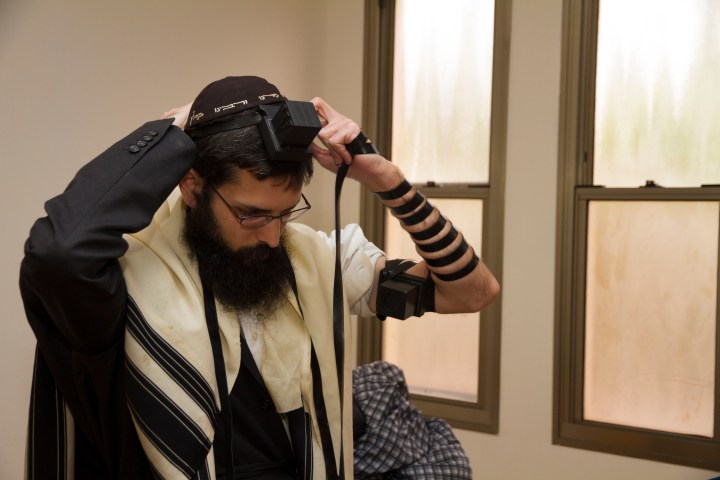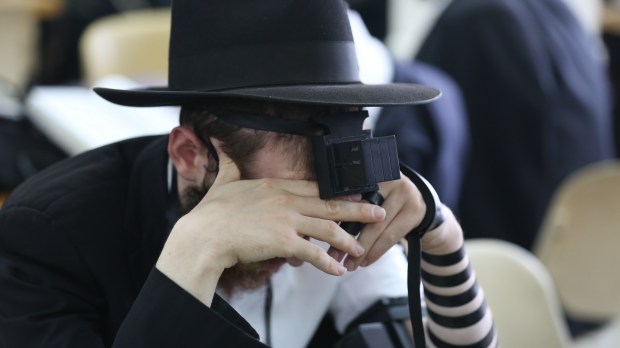If you haven’t already, you’ll want to check out Shtisel, the delightful Israeli television series, now streaming on Netflix, that follows the lives of a fictional “ultra-Orthodox” Jewish family living in Jerusalem.
Lauded by the secular media for “humanizing” a community that is often depicted as insular and backward, the series depicts an extended family striving to live by the strictures of their faith, and not always completely succeeding.
In the series “tefillin,” or “phylacteries” in English, serve as a useful plot device to indicate an outward sign of faith. These black leather boxes containing Torah readings inscribed on tiny scrolls of parchment are strapped onto the arms and forehead of Orthodox Jewish men during daily prayer. To forget to pray with tefillin, as the young Akiva Shtisel does just as his life is taking an unorthodox turn, is not good at all. It is to forget the Torah’s instructions to remember that God intervened to help the Israelite escape from Egypt.

Tefillin in the Old Testament
Why do observant Jews wear tefillin? The bible verses commonly cited as the basis for the obligation to wear tefillin are:
- And it shall be for a sign for you upon your hand, and for a memorial between your eyes, that the law of the Lord may be in your mouth; for with a strong hand did the Lord bring you out of Egypt.—Exodus 13:9
- And it shall be for a sign upon your hand, and as totafot between your eyes; for with a mighty hand did the Lord bring us forth out of Egypt.—Exodus 13:16
- And you shall bind them as a sign upon your arm, and they shall be as totafot between your eyes.—Deuteronomy 6:8
- You shall put these words of mine on your heart and on your soul; and you shall tie them for a sign upon your arm, and they shall be as totafot between your eyes.—Deuteronomy 11:18
Archaeological evidence of tefillin
In recent years archaeologists have unearthed evidence that indicates that the Jewish people used tefillin in the the first century AD.
In 2013, Dr. Yonatan Adler discovered that nine tiny scroll fragments were among the Dead Sea Scrolls originally found in the caves in Qumran in the Judean desert in 1946.
The previously unexamined scrolls were tefillin, according to Adler, a lecturer at Ariel University and a post-doctoral researcher on Qumran tefillin (phylacteries) at Hebrew University. After finding a phylactery case, Adler examined it under an MRI, and found that it contained scrolls. He then came across several more sets of phylacteries with scrolls inside, according to an article at Israel365News.com.
The tiny scrolls had been sitting unnoticed in a lab for decades. So why wasn’t this discovery reported?
“Either they didn’t realize that these were also scrolls, or they didn’t know how to open them,” Pnina Shor, head of the IAA’s Department of Artefact Treatment and Conservation, said, according to the report.
Did Jesus wear tefillin?
The archaeological evidence discovered in Qumran establishes that tefillin were worn in the Jesus’ lifetime. Some scholars go even further to suggest that Jesus may have been a member of the community that inhabited these caves.
The Qumran caves where the Dead Sea Scrolls (and tefillin) were discovered were inhabited by a Jewish sect called the Essenes. This ascetic Jewish community both pre-dated and was contemporary with John the Baptist and Jesus of Nazareth. While some theorize that Jesus and John the Baptist were themselves Essenes, others find no conclusive evidence to suggest this is true.
Perhaps more telling, is a biblical passage in which Jesus rails against the ostentatious wearing of tefillin by the Pharisees (Mathew, Chapter 23):
Then Jesus spoke to the crowds and to his disciples, saying, “The scribes and the Pharisees have taken their seat on the chair of Moses.
Therefore, do and observe all things whatsoever they tell you, but do not follow their example. For they preach but they do not practice.
They tie up heavy burdens [hard to carry] and lay them on people’s shoulders, but they will not lift a finger to move them.
All their works are performed to be seen. They widen their phylacteries and lengthen their tassels.
While some might suggest that this caution against large phylacteries implies that Jesus himself did not wear phylacteries, the passage may actually suggest just the opposite.
Even though Jesus rails against the Pharisees for lengthening their “tassels,” there is biblical evidence to show he wore tassels himself, as would any devout Jew.
The Torah contains the instruction to “Make yourself bound tassels on the four corners of clothing with which you cover yourself (Deuteronomy 22:12). There are four passages in the Gospels in which Jesus is seen to wear tassels on his garments (Matthew 9:20; 14:36; Mark 6:56; Luke 8:44).
Therefore, it is possible, if not likely, that Jesus was criticizing ostentatious shows of faith — such as wearing large tefillin and long tassels. The criticism could be seen as implying that modestly-sized teffilin and tassels, were legitimate and appropriate outward signs of faith, according to Jesus.

